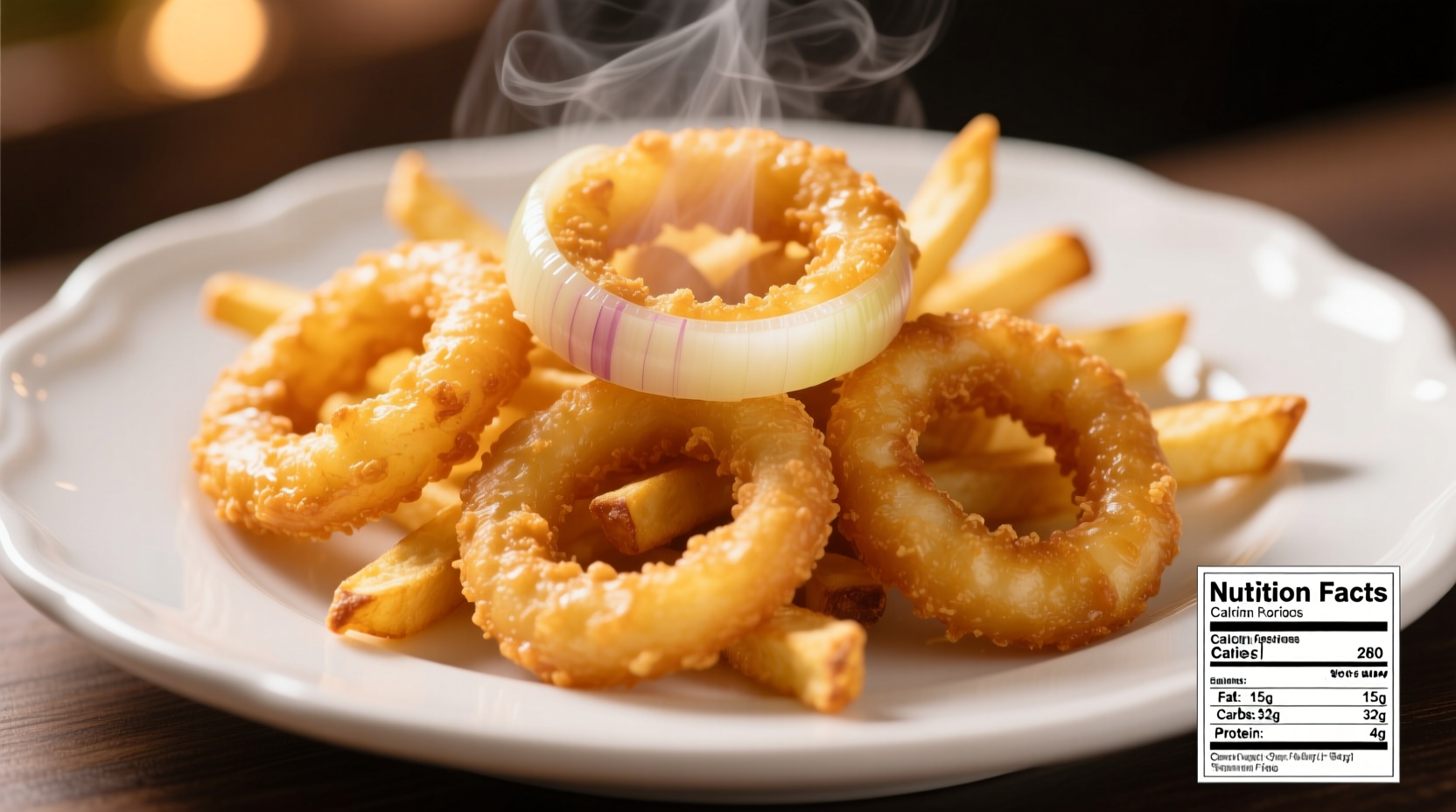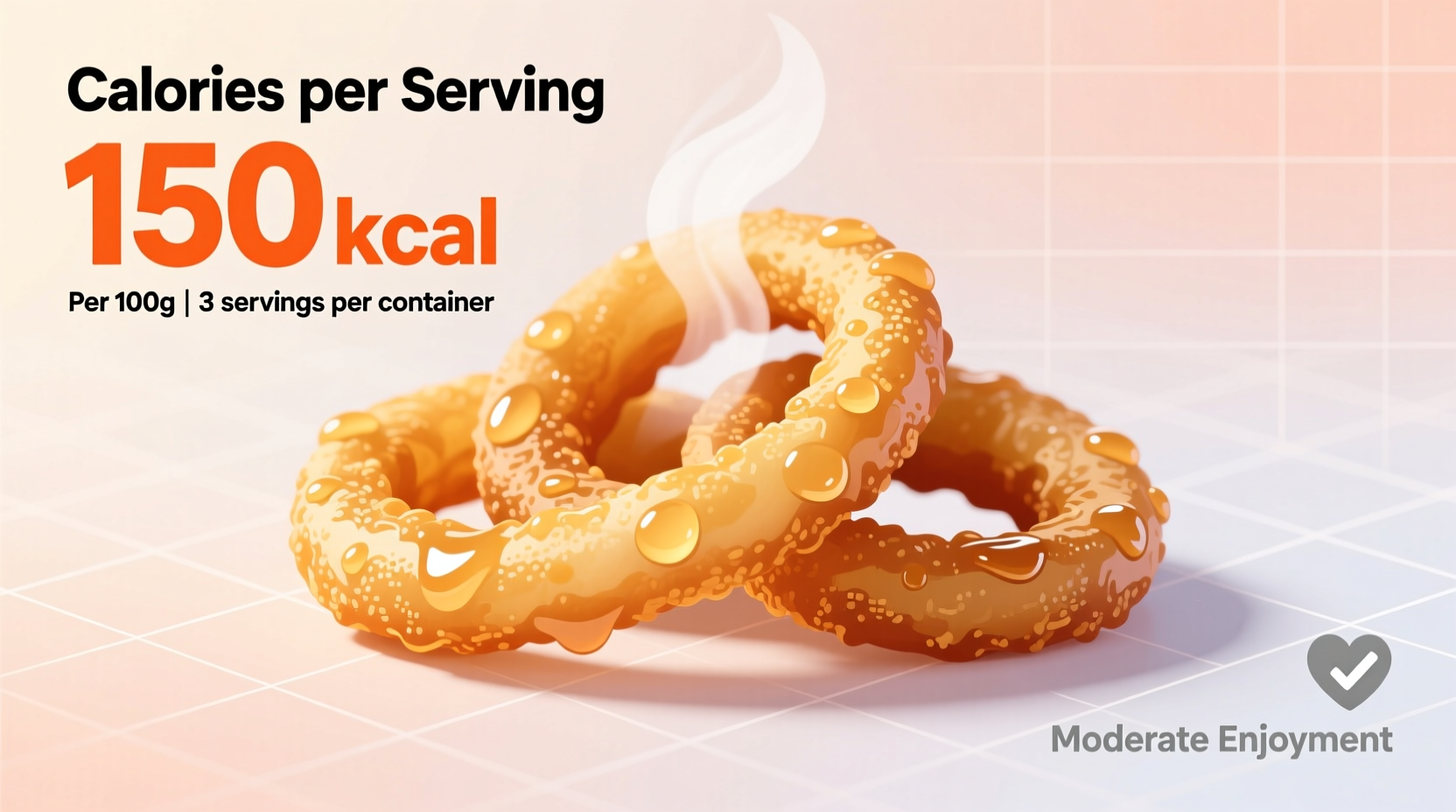Understanding the calorie content of onion rings is essential for making informed dietary choices without sacrificing enjoyment. Whether you're dining out or cooking at home, knowing exactly what goes into this popular side dish helps balance indulgence with nutritional awareness.
Breaking Down Onion Ring Calories: What Really Matters
When evaluating "how many calories in onion rings," it's crucial to recognize that preparation method dramatically impacts nutritional content. The difference between restaurant-style and homemade versions can be substantial, making context vital for accurate calorie counting.
Standard Calorie Counts by Preparation Method
Based on USDA FoodData Central measurements, here's how calorie counts vary across common preparation methods:
| Preparation Method | Portion Size | Calories | Total Fat (g) |
|---|---|---|---|
| Deep-fried (restaurant) | 3 oz (85g) | 273 | 14.5 |
| Deep-fried (homemade) | 3 oz (85g) | 245 | 12.8 |
| Air-fried | 3 oz (85g) | 185 | 7.2 |
| Baked | 3 oz (85g) | 165 | 4.5 |
This nutritional comparison reveals why preparation technique significantly affects calorie content. Deep-fried versions absorb more oil during cooking, substantially increasing both calories and fat content compared to air-fried or baked alternatives.
Key Factors That Change Calorie Counts
Several variables influence the final calorie count in your onion rings:
- Batter composition: Traditional beer batter adds approximately 30-50 more calories per serving than simple flour coatings
- Oil type: Vegetable oil versus peanut oil creates minor calorie variations (about 5-10 calories per serving)
- Portion size: Restaurant servings often exceed standard 3-ounce portions by 50-100%, dramatically increasing total calories
- Onion thickness: Thicker rings require more batter and absorb more oil, adding 20-40 calories per serving
Historical Evolution of Onion Ring Preparation
Understanding how preparation methods have evolved helps explain modern calorie differences. The timeline of onion ring cooking techniques shows:
- 1920s: First commercial production using thick-cut onions with minimal batter
- 1950s: Introduction of standardized batter recipes in fast food chains
- 1980s: Shift toward heavier batters and increased oil absorption for crispier texture
- 2010s: Emergence of air-frying technology reducing oil absorption by 60-70%
This historical context explains why modern restaurant onion rings typically contain more calories than their mid-20th century counterparts. The pursuit of crunchier texture has inadvertently increased calorie density over time.

Practical Strategies for Mindful Consumption
Enjoying onion rings while managing calorie intake requires strategic approaches:
- Portion control: Request a half-order when dining out to reduce calories by 30-40%
- Sharing strategy: Split an order with a dining companion to maintain social enjoyment while cutting calories
- Homemade advantage: Use panko breadcrumbs instead of traditional batter for 25% fewer calories
- Timing consideration: Enjoy onion rings earlier in the day when your metabolism is most active
How Onion Rings Compare to Other Popular Sides
Understanding "how many calories in onion rings" becomes more meaningful when compared to alternatives:
- Onion rings (3oz): 273 calories vs French fries (3oz): 365 calories
- Onion rings contain 20% more fiber than standard French fries
- Side salad with light dressing: 70-100 calories (but lacks the satisfying crunch)
- Sweet potato fries: 290 calories with higher vitamin A content
This comparison shows that while onion rings aren't the lowest-calorie option, they offer a middle ground between nutritional value and indulgence when compared to other fried sides.
Nutritional Context Beyond Calories
When evaluating "calories in onion rings nutrition facts," consider these additional nutritional factors:
- Carbohydrates: 30-35g per serving (primarily from batter)
- Protein: Only 3-4g per serving (minimal nutritional protein)
- Sodium: 300-500mg depending on seasoning (can exceed 20% of daily recommended)
- Vitamin C: Onions provide approximately 10% of daily value
These nutritional elements help create a complete picture beyond just calorie counting, allowing for more informed dietary decisions.
When Calorie Information Applies (and When It Doesn't)
It's important to recognize the context boundaries for standard calorie information:
- Chain restaurant nutrition data applies only to standardized recipes (varies by location)
- Homemade versions depend entirely on specific ingredients and techniques used
- "How many calories in restaurant onion rings" differs significantly between establishments
- Nutritional information assumes standard oil absorption (deep fryers with fresh oil vs. reused oil)
These context boundaries explain why calorie counts can vary by as much as 100 calories between seemingly identical onion ring preparations.
Creating Lower-Calorie Versions Without Sacrificing Flavor
Professional chefs have developed techniques to reduce calories while maintaining the beloved onion ring experience:
- Use egg white wash instead of full egg for lighter adhesion
- Apply a single, thin layer of batter rather than multiple coatings
- Soak onions in buttermilk before breading for better adhesion with less coating
- Chill coated onions before cooking to reduce oil absorption
- Use cornflake crumbs instead of traditional flour batter for crunch with fewer calories
These professional techniques can reduce calorie content by 30-40% while preserving the satisfying crunch that makes onion rings so appealing.











 浙公网安备
33010002000092号
浙公网安备
33010002000092号 浙B2-20120091-4
浙B2-20120091-4